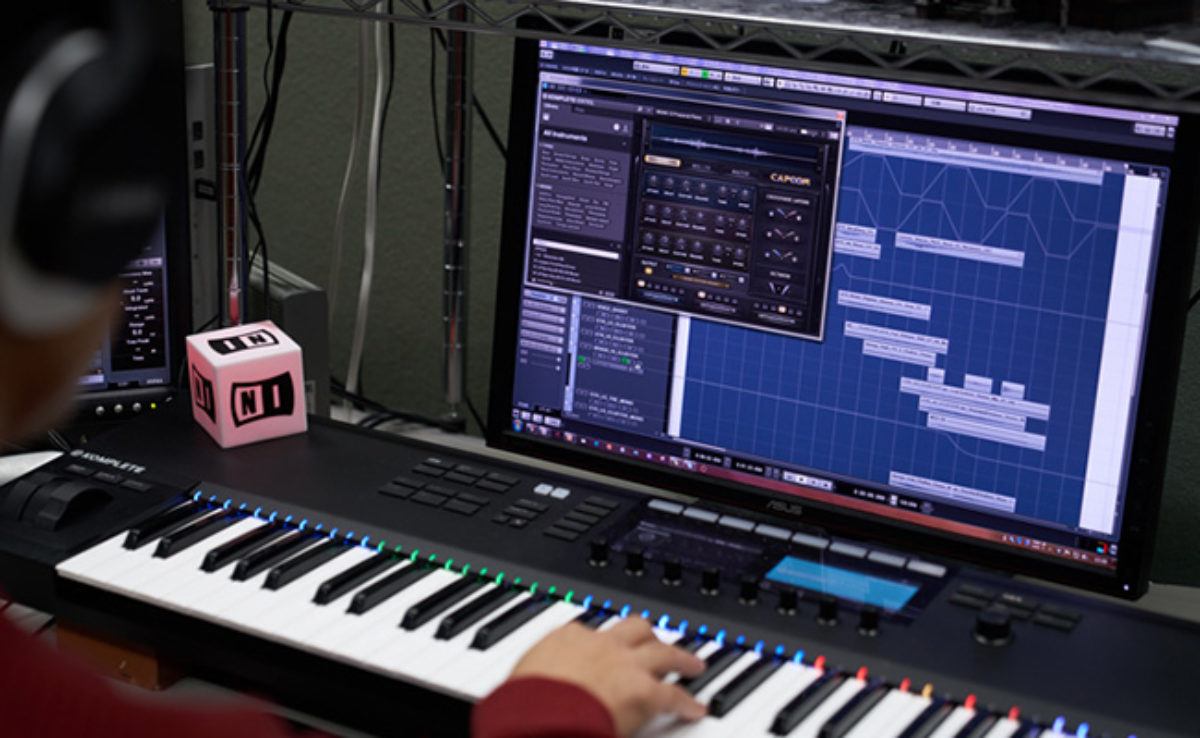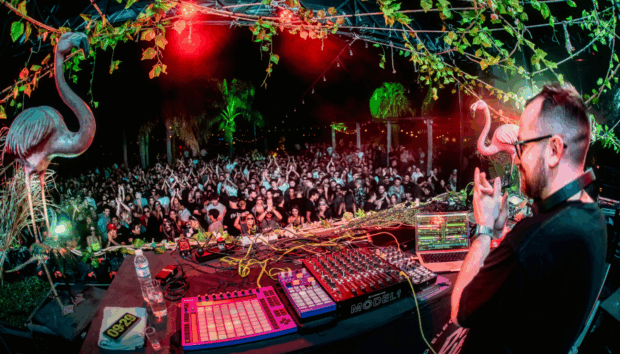
With enthusiastic fans all over the world, Resident Evil is one of the most emblematic horror game series, with the latest instalment, Resident Evil 7: Biohazard, released in January 2017. In a dialogue with three of the minds behind the game’s sinister sonics – Sound Designer Mr. Usami; Composer Mr. Morimoto; and Audio Director Mr. Hachisako – Tetsuya Higashi uncovers the key tools within their inventory, and discovers how they masterfully engineer our fear via music.
What does the sound/music team for a game like Resident Evil 7 usually look like?
Usami: It depends on the project, but typically we have one Audio Director who looks after the overall landscape of the sound; six or seven Sound Designers; one Voice Editor; three Composers; two Sound Programmers who are responsible for implementing sound in the game; one Mixing Engineer; and one Audio Producer who commissions all outsourced tasks. So overall, there’s about 20-odd staff – and if we include the outsourced contractors, the team grows even larger.
Can you give us some specifics on your own role as Sound Designer?
Usami: I’m responsible for creating what we call “props” and “gimmicks”. That’s a bit of internal Capcom jargon, but it means the sound effects related to tools and items in the game. In Resident Evil 7: Biohazard, there are a huge number of incidental items such as doors, vases, or fridges – these everyday sound effects are props. Sounds that do not occur/cannot be heard in daily life; that are more related to the “staging” and effects of the game; those you hear when a machine or an effect are in motion, are gimmicks.
I also create and implement ambient sounds, and sounds that are intended to surprise the player – we call them “level design” sound effects.
Where were the props and gimmicks recorded?
Usami: We used two main locations: the Foley stage at the TOHO Post-Production Center, and the in-house Foley stage at Capcom. We brought these everyday items into the studio and recorded their sounds into Pro Tools. The main microphones we used were the AKG C414 and Sennheiser 416. Schoeps microphones were also used.
Can you describe the setup of the microphones?
Usami: When recording performances with foley artist, we generally used two microphones side by side. The Sennheiser 416 for the more proximal sound, with sharp profile and refined detail, whereas the AKG C414 was placed slightly further away from the object. The C414 captured more of the atmosphere or “air”. We also tried the Schoeps instead of the 416, but in the end we settled down with the combination of the C414 and 416.
Did you apply any effects in Pro Tools?
Usami: Only compressors. I guess the most important aspect in terms of Foley sound effects is the reverberation, but this is processed dynamically inside the game, so we didn’t apply any reverb while recording. In the game, the desired reverb is applied to sounds as the player enters various scenes or rooms. So we tried to record as dry as possible, being faithful to the original sound.

There must be a lot of sound effects in a game like Resident Evil 7 — how many did you record?
Usami: Over 700 props/gimmicks in total, including ambient sounds such as water droplets and mould falling on the floor.
Next question is to you, Morimoto. Your were the Composer, right?
Morimoto: Yes, and I’m responsible not only for the compositions, but also designing, for example, the timing of the music onset, sound direction, and the overall flow. I am also responsible for the [technical] implementation of the music.
How many pieces did you compose for Resident Evil 7, and how long were they?
Morimoto: About 80 pieces. For length, it depends, but about a minute-and-a half, to two minutes. The passages are looped, so they can’t be too short. And for scenes where the playing time is longer – typically battle scenes – there will be a development in the piece, and so it tends to end up longer too.
When you’re composing, what software do you use?
Morimoto: I used Cubase Pro for the main DAW, and an in-house tool for KONTAKT called REMM – it stands for “Resident Evil Music Module”. In short, REMM is a tool we designed for creating tone colors for use in the music of Resident Evil 7. We outsourced the development, and the final product incorporates the developers’ ideas as welI.
Sounds intriguing! Why did you decide to create REMM inside KONTAKT?
Morimoto: First, we decided to use the techniques of musique concrete, as we came to the conclusion that tone colors were extremely important for this project. Before developing REMM, we did lots of investigation using KONTAKT, and we found its ease and simplicity of processing the sampled sounds very attractive. Also, all the composers were already using KONTAKT, so it was easy for us to share the tone colors.
So all the composers had KONTAKT?
Morimoto: Yes – quite a lot of composers use KONTAKT. With REMM, I think it was a big advantage that we were improving on a tool we were all familiar with instead of introducing a new sampler or software.
Could you tell us more about tone color creation using REMM?
Morimoto: First, the unprocessed sounds are imported into REMM using the Mapping Editor. REMM has built-in parameters for knobs, effects, and playback speed controls, such as attack, decay, and release, which we use to process the sounds. Take the sound of a bell, for example. You could reduce the attack time to make the tone more ambient, or reduce the playback speed to lower the pitch. REMM also incorporates three layers, so for example, we might blend the sound of a voice with that of a string cluster.
Does REMM have effects too?
Morimoto: Basic effects needed for sound processing, such as reverb, filtering, and compression. These effects can be applied to individual layers and are set from the MIX/FX section.
What aspects did you put a particular focus on while composing for Resident Evil 7?
Morimoto: With Resident Evil 7, it is not just about the music the player hears during play. They will encounter diverse scenes, some with sound effects such as props mentioned earlier and ambient sounds, and some with voices. So it was important to thoroughly work through each scene and develop a firm idea about the kind of music needed. For example, if it’s enough to have a drone, or whether to juxtapose that with a melody. Another thing I kept in mind while composing was the feeling evoked by the music: what people feel when hearing music without scales and with scales; or during the transition from dissonance to a consonant, pleasant, well-tempered passage of music.
Did you use any other Native Instruments products apart from KONTAKT for this project?
Morimoto: Yes, I used the piano sound library THE GIANT, which is in KOMPLETE. THE GIANT contains a number of unique tones such as attack noises, dissonances, and the squeal of strings being scraped. The music for one of the antagonists, Marguerite, is composed mainly using these tones. Sounds from MASSIVE were also used in the trailer for the game.

Why were you drawn to MASSIVE for this particular purpose?
Morimoto: A lot of its sounds have a strong attack and are ear-catching, so I used them when, for example, captions are displayed.

Are there some unique points of Native Instruments products that make them especially useful in your line of work?
Morimoto: First of all, the products from Native Instruments offer very high sound quality. When composing, a considerable amount of time is spent for searching for appropriate tones – the sophisticated user interface of NI products is helpful in finding them quickly. Additionally, our job requires a full gamut of sounds and my impression is that the range of genres covered by NI is wide and comprehensive. They are very comfortable to use.
Turning to Mr. Hachisako, can you outline the roles and responsibilities of Audio Director?
Hachisako: This position is responsible for the overall sound of the game: supervising the general direction towards which the sound should be designed, the voices that should be staged, and the music composed. Sometimes, these decisions are made in cooperation with a member of the production team.
So you often work together with Mr. Usami and Mr. Morimoto?
Hachisako: Yes, that’s right.
Do you also use Native Instruments products in your work?
Hachisako: Yes — for this project, I used ABSYNTH to create the ringtone and dialling tone for the main character’s Codex, which is a watch-like communication device.
About ABSYNTH, what caught your attention with this particular instrument?
Hachisako: ABSYNTH is a modular-type synthesiser, where functions such as oscillator, filter, or granular synthesis can be freely combined. In addition, you can call up an arbitrary waveform from the library or create one yourself. I like working on fine details, so I’ve always been very fond of such features, and I had been using the software for a while.

Can you tell us about the ABSYNTH patch used to create the Codex sound?
Hachisako: I applied granular synthesis, filters, clouds, and wave shapes to the existing presets. I also modulated the waveform itself to give a slightly phase-distorted wah wah-ish sound.
As the leader of the Resident Evil 7 sound team, what do you want players to enjoy most about the game?
Hachisako: In terms of the concept of “the sound of horror” that we came up for this game, I would like players to focus on the small details and enjoy the diverse tones. The sounds, whether they’re ambient sounds, individual props, or footsteps, are created with extremely realistic tones. That is definitely something to pay attention to. By focusing on these details, I think players can enjoy an increased sense of fear and survival.
And the same question to you, Mr. Usami.
Usami: As Hachisako mentioned, even the smallest item in this game has a sound attached to it. So if you listen carefully, I think you will be impressed by the granularity of our work. That said, we also tried to avoid sounds that don’t convey any meaning – so for example, a subtle sound that at first seems arbitrary] occurs just before the onset of an event. Myself, Morimoto, Hachisako and the whole sound team worked together to create such sounds. If you play it using VR, we can certainly guarantee a terrifying experience.
The fear factor must be enhanced even further with a three-dimensional sound field!
Usami: Definitely. It’s effective enough on headphones, but with the virtual surround effect, you can truly enjoy the experience. I would certainly recommend to play the game with such a setup.
This article was originally commissioned and published by TuneGate and can be read here.















